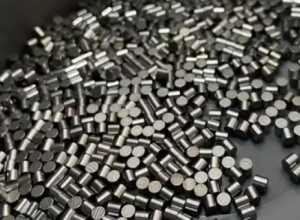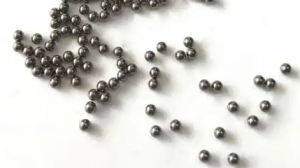Tantalum Needles & Tantalum Beads in Medical Procedures

Introduction
In the world of medical procedures, tantalum markers enhance precision and stability, particularly in spinal fusion devices and implantation procedures. This article is going to discuss the dual forms of tantalum markers--the needle for spinal fusion and the beads for radiographic guidance. Hope that you can have a better understanding of their versatile designs and indispensable contributions to medical interventions.
Understanding Tantalum Products
Tantalum is a remarkable transition metal with exceptional properties. It stands as a key player in various industries due to its versatility and unique characteristics. From its high melting point to its remarkable corrosion resistance, tantalum products have found indispensable applications across multiple domains, especially in electronics, aerospace, and healthcare.

Tantalum [1]
- Thermal Performance: At its core, tantalum boasts a melting point surpassing 3,000 degrees Celsius, so it has become one of the most heat-resistant metals available. This remarkable attribute renders tantalum products ideal for applications in high-temperature environments. For instance, in the aerospace industry, Ta contributes to the production of heat-resistant components for aircraft engines and structural materials for spacecraft.
- Corrosion Resistance: Moreover, tantalum’s remarkable resistance to corrosion—exceeding that of stainless steel and titanium—elevates its significance in various chemical and industrial settings. Therefore, tantalum products maintain their structural integrity and performance even in highly corrosive environments, and they become invaluable in chemical processing, nuclear reactors, and the manufacture of surgical instruments.
- Electronic capacitance: In the realm of electronics, tantalum capacitors are distinguished for their high capacitance and stability. These Ta capacitors are utilized extensively in electronic devices and offer superior performance in terms of reliability, miniaturization, and energy storage.
However, tantalum's contributions extend beyond industrial applications. In the healthcare sector, thanks to its biocompatibility and radiopacity, Ta has become an ideal material for medical implants and diagnostic devices. Tantalum markers, in the form of beads or needles, assist surgeons in procedures like spinal fusion and implantation with efficiency and versatility.
1. Tantalum Marker Needles in Spinal Fusion
The primary form of a tantalum marker for spinal fusion devices takes the shape of a marker needle. It is delicately crafted from tantalum wire or rod. These needles offer surgeons the flexibility to insert them at varying lengths. This versatility empowers surgeons with a spectrum of choices for pinpointing the optimal entry point in the spinal implant during procedures.

Tantalum Rods
Additionally, the needle's biocompatibility and radiopacity ensure clear visibility in medical imaging, specifically X-ray images. Also, the ability to insert the tantalum marker needle at different lengths provides the surgeon with flexibility. This allows for a customized approach based on the specific needs of the patient and the details of the surgical procedure.
2. Tantalum Marker Beads for Radiographic Guidance
Beyond spinal fusion, tantalum beads and balls emerge as unsung heroes in implantation procedures throughout the body. Their small, spherical form strategically designed for insertion into human tissue proves invaluable in areas like the hip, knee, and spine.

Tantalum Beads and Balls
The distinctive advantage of these tantalum markers lies in their appearance as precise dots in radiographs. This radiographic visibility becomes a visual reference point for surgeons, so they can monitor and assess implant displacement with exceptional accuracy.
3. Advanced Measurement Techniques: Radiostereometric Analysis (RSA)
Let’s delve into the significance of tantalum beads in visualizing shifts during implantation--the advanced measurement techniques like Radiostereometric Analysis (RSA).
Radiostereometric Analysis (RSA) has revolutionized the precision with which surgeons can measure implant displacement. By utilizing tantalum beads as markers, RSA involves capturing X-ray images from the patient. These images not only reveal the positions of the tantalum beads but also allow surgeons to accurately determine the degree of displacement of the implant with remarkable precision, often up to 0.1 mm.
Benefits of Tantalum Markers
Both tantalum needles and tantalum beads share various advantages in the medical field. These tantalum products are known for exceptional corrosion resistance, high melting point, and biocompatibility.
First, Ta has a higher density (16 g/cm³), which is 50% higher than that of lead (Pb). Therefore, the non-transmission linearity is stronger. For this reason, tantalum markers only need to be examined with lower exposure doses of X-rays. Moreover, tantalum is highly biocompatible and has been used in surgery for more than 30 years without any serious incidents reported. Tantalum X-ray markers are currently one of the safest options.
Besides, Ta needles and Ta beads come with impressive precision and efficiency. For instance, the precision offered by tantalum beads and the RSA technique is unparalleled in the field of implantation. Surgeons can not only visualize but also quantitatively measure the displacement of implants, allowing for adjustments and corrections with a high degree of accuracy.
Conclusion
Overall, in the dynamic field of medical interventions, tantalum markers, whether in needle or bead form, stand as silent architects of precision. Their versatility, coupled with advanced measurement techniques, reshapes the landscape of surgical procedures. As we navigate the future of medical science, these dual forms of tantalum markers continue to steer the course toward enhanced precision and ultimately define a new standard in patient care and medical excellence.
Stanford Advanced Materials (SAM) is a reliable supplier of different forms of tantalum markers. Both needles and beads are available on our site. You can also find platinum, gold, and palladium marker bands at SAM. Send us an inquiry if you are interested.
Reference:
[1] Britannica, T. Editors of Encyclopaedia (2023, July 14). tantalum. Encyclopedia Britannica. https://www.britannica.com/science/tantalum
{{item.content}}
LEVE A REPLY
{{item.children[0].content}}
{{item.content}}






